2013 BMW 640I COUPE tire size
[x] Cancel search: tire sizePage 98 of 232
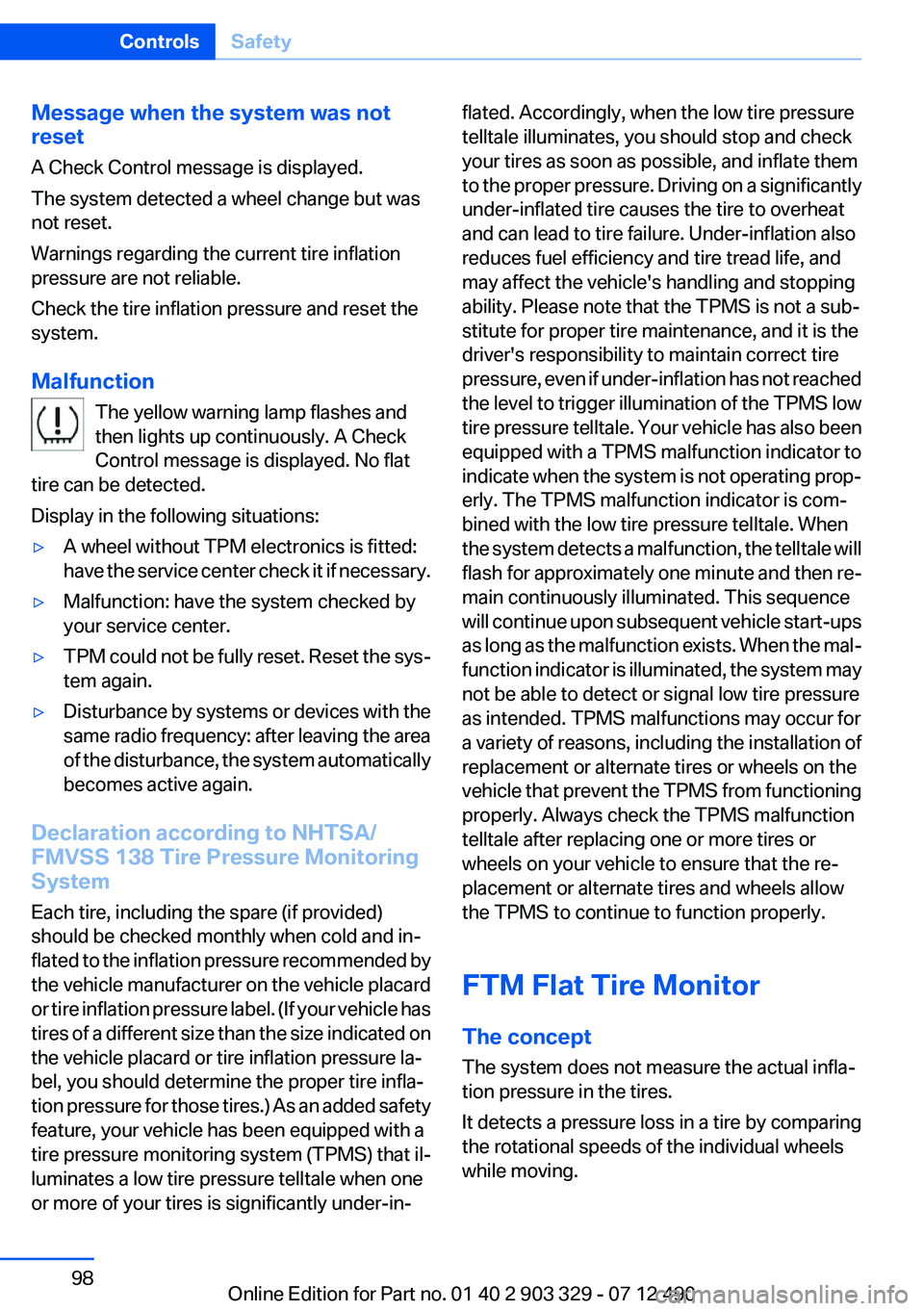
Message when the system was not
reset
A Check Control message is displayed.
The system detected a wheel change but was
not reset.
Warnings regarding the current tire inflation
pressure are not reliable.
Check the tire inflation pressure and reset the
system.
Malfunction The yellow warning lamp flashes and
then lights up continuously. A Check
Control message is displayed. No flat
tire can be detected.
Display in the following situations:▷A wheel without TPM electronics is fitted:
have the service center check it if necessary.▷Malfunction: have the system checked by
your service center.▷TPM could not be fully reset. Reset the sys‐
tem again.▷Disturbance by systems or devices with the
same radio frequency: after leaving the area
of the disturbance, the system automatically
becomes active again.
Declaration according to NHTSA/
FMVSS 138 Tire Pressure Monitoring
System
Each tire, including the spare (if provided)
should be checked monthly when cold and in‐
flated to the inflation pressure recommended by
the vehicle manufacturer on the vehicle placard
or tire inflation pressure label. (If your vehicle has
tires of a different size than the size indicated on
the vehicle placard or tire inflation pressure la‐
bel, you should determine the proper tire infla‐
tion pressure for those tires.) As an added safety
feature, your vehicle has been equipped with a
tire pressure monitoring system (TPMS) that il‐
luminates a low tire pressure telltale when one
or more of your tires is significantly under-in‐
flated. Accordingly, when the low tire pressure
telltale illuminates, you should stop and check
your tires as soon as possible, and inflate them
to the proper pressure. Driving on a significantly
under-inflated tire causes the tire to overheat
and can lead to tire failure. Under-inflation also
reduces fuel efficiency and tire tread life, and
may affect the vehicle's handling and stopping
ability. Please note that the TPMS is not a sub‐
stitute for proper tire maintenance, and it is the
driver's responsibility to maintain correct tire
pressure, even if under-inflation has not reached
the level to trigger illumination of the TPMS low
tire pressure telltale. Your vehicle has also been
equipped with a TPMS malfunction indicator to
indicate when the system is not operating prop‐
erly. The TPMS malfunction indicator is com‐
bined with the low tire pressure telltale. When
the system detects a malfunction, the telltale will
flash for approximately one minute and then re‐
main continuously illuminated. This sequence
will continue upon subsequent vehicle start-ups
as long as the malfunction exists. When the mal‐
function indicator is illuminated, the system may
not be able to detect or signal low tire pressure
as intended. TPMS malfunctions may occur for
a variety of reasons, including the installation of
replacement or alternate tires or wheels on the
vehicle that prevent the TPMS from functioning
properly. Always check the TPMS malfunction
telltale after replacing one or more tires or
wheels on your vehicle to ensure that the re‐
placement or alternate tires and wheels allow
the TPMS to continue to function properly.
FTM Flat Tire Monitor
The concept
The system does not measure the actual infla‐
tion pressure in the tires.
It detects a pressure loss in a tire by comparing
the rotational speeds of the individual wheels
while moving.Seite 98ControlsSafety98
Online Edition for Part no. 01 40 2 903 329 - 07 12 490
Page 106 of 232
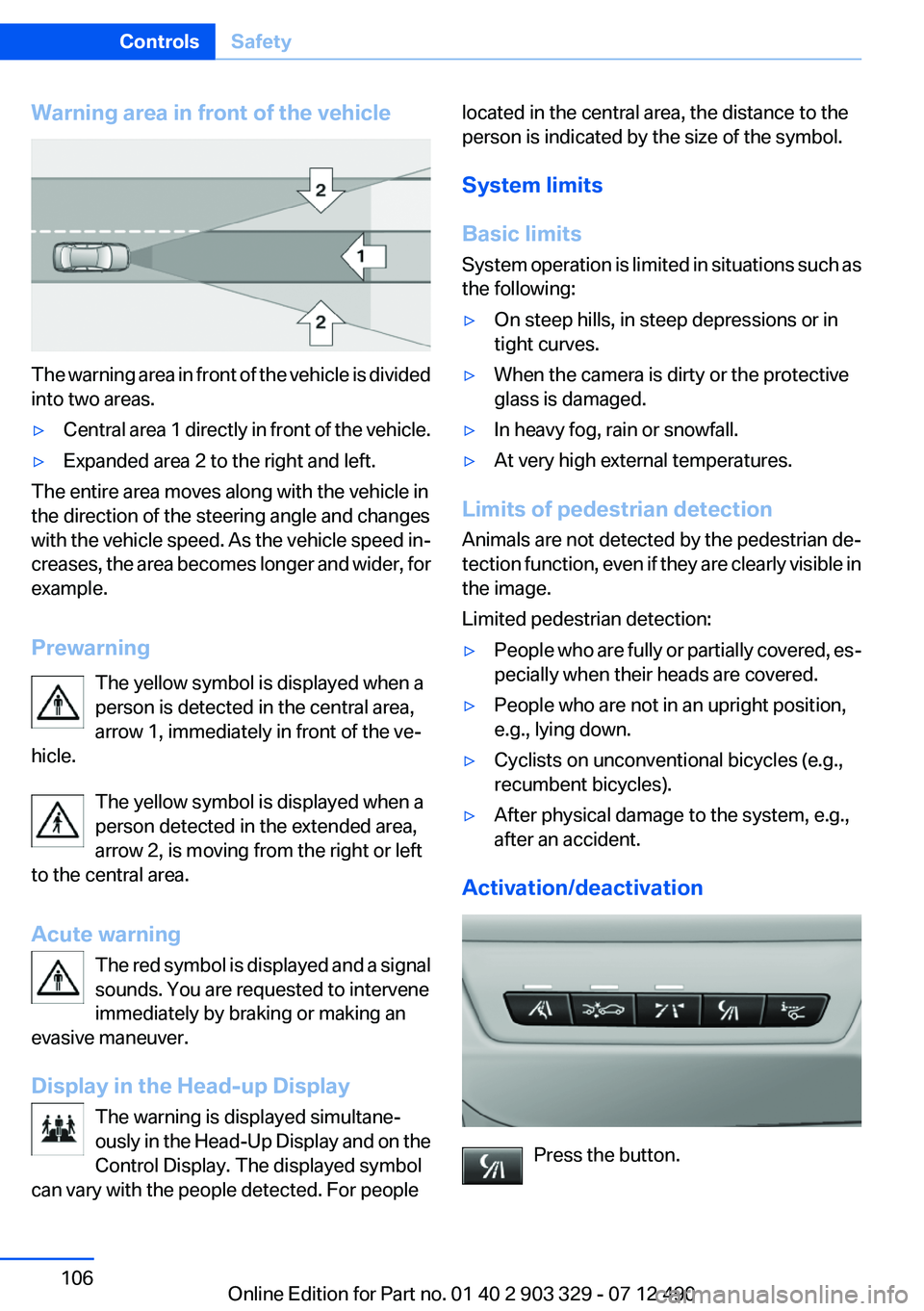
Warning area in front of the vehicle
The warning area in front of the vehicle is divided
into two areas.
▷Central area 1 directly in front of the vehicle.▷Expanded area 2 to the right and left.
The entire area moves along with the vehicle in
the direction of the steering angle and changes
with the vehicle speed. As the vehicle speed in‐
creases, the area becomes longer and wider, for
example.
Prewarning The yellow symbol is displayed when a
person is detected in the central area,
arrow 1, immediately in front of the ve‐
hicle.
The yellow symbol is displayed when a
person detected in the extended area,
arrow 2, is moving from the right or left
to the central area.
Acute warning The red symbol is displayed and a signal
sounds. You are requested to intervene
immediately by braking or making an
evasive maneuver.
Display in the Head-up Display The warning is displayed simultane‐
ously in the Head-Up Display and on the
Control Display. The displayed symbol
can vary with the people detected. For people
located in the central area, the distance to the
person is indicated by the size of the symbol.
System limits
Basic limits
System operation is limited in situations such as
the following:▷On steep hills, in steep depressions or in
tight curves.▷When the camera is dirty or the protective
glass is damaged.▷In heavy fog, rain or snowfall.▷At very high external temperatures.
Limits of pedestrian detection
Animals are not detected by the pedestrian de‐
tection function, even if they are clearly visible in
the image.
Limited pedestrian detection:
▷People who are fully or partially covered, es‐
pecially when their heads are covered.▷People who are not in an upright position,
e.g., lying down.▷Cyclists on unconventional bicycles (e.g.,
recumbent bicycles).▷After physical damage to the system, e.g.,
after an accident.
Activation/deactivation
Press the button.
Seite 106ControlsSafety106
Online Edition for Part no. 01 40 2 903 329 - 07 12 490
Page 173 of 232
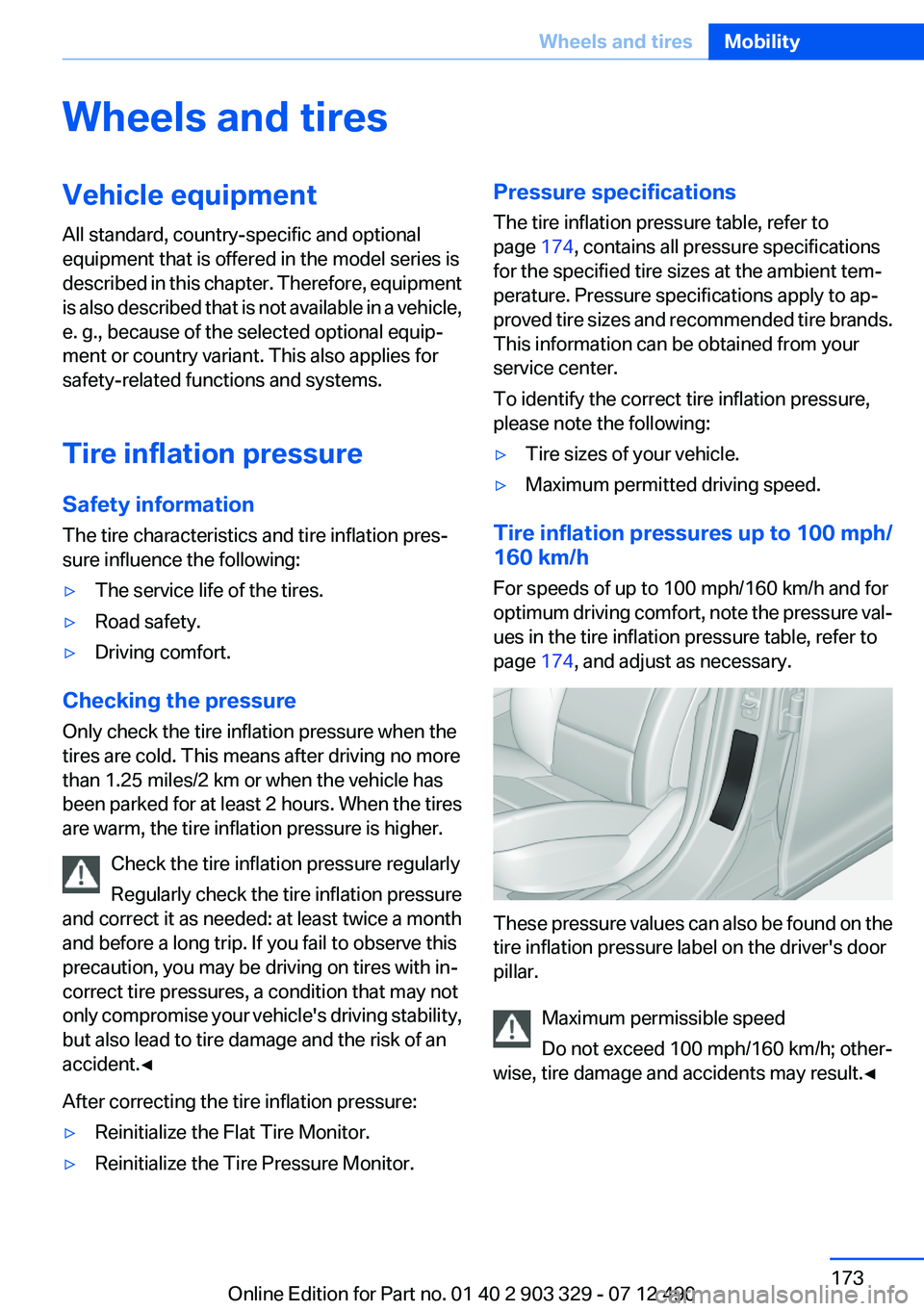
Wheels and tiresVehicle equipment
All standard, country-specific and optional
equipment that is offered in the model series is
described in this chapter. Therefore, equipment
is also described that is not available in a vehicle,
e. g., because of the selected optional equip‐
ment or country variant. This also applies for
safety-related functions and systems.
Tire inflation pressure
Safety information
The tire characteristics and tire inflation pres‐
sure influence the following:▷The service life of the tires.▷Road safety.▷Driving comfort.
Checking the pressure
Only check the tire inflation pressure when the
tires are cold. This means after driving no more
than 1.25 miles/2 km or when the vehicle has
been parked for at least 2 hours. When the tires
are warm, the tire inflation pressure is higher.
Check the tire inflation pressure regularly
Regularly check the tire inflation pressure
and correct it as needed: at least twice a month
and before a long trip. If you fail to observe this
precaution, you may be driving on tires with in‐
correct tire pressures, a condition that may not
only compromise your vehicle's driving stability,
but also lead to tire damage and the risk of an
accident.◀
After correcting the tire inflation pressure:
▷Reinitialize the Flat Tire Monitor.▷Reinitialize the Tire Pressure Monitor.Pressure specifications
The tire inflation pressure table, refer to
page 174, contains all pressure specifications
for the specified tire sizes at the ambient tem‐
perature. Pressure specifications apply to ap‐
proved tire sizes and recommended tire brands.
This information can be obtained from your
service center.
To identify the correct tire inflation pressure,
please note the following:▷Tire sizes of your vehicle.▷Maximum permitted driving speed.
Tire inflation pressures up to 100 mph/
160 km/h
For speeds of up to 100 mph/160 km/h and for
optimum driving comfort, note the pressure val‐
ues in the tire inflation pressure table, refer to
page 174, and adjust as necessary.
These pressure values can also be found on the
tire inflation pressure label on the driver's door
pillar.
Maximum permissible speed
Do not exceed 100 mph/160 km/h; other‐
wise, tire damage and accidents may result.◀
Seite 173Wheels and tiresMobility173
Online Edition for Part no. 01 40 2 903 329 - 07 12 490
Page 174 of 232
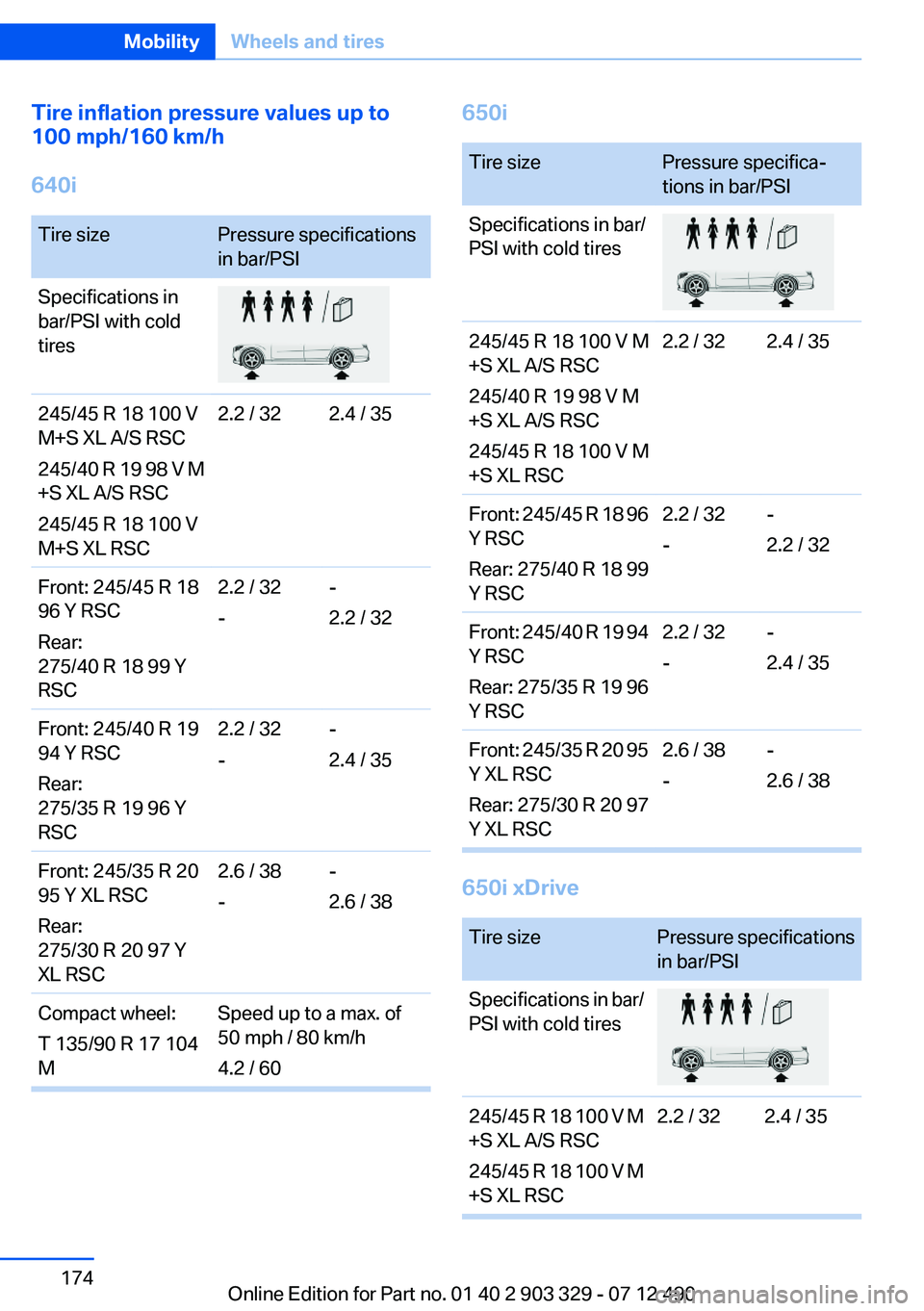
Tire inflation pressure values up to
100 mph/160 km/h
640iTire sizePressure specifications
in bar/PSISpecifications in
bar/PSI with cold
tires245/45 R 18 100 V
M+S XL A/S RSC
245/40 R 19 98 V M
+S XL A/S RSC
245/45 R 18 100 V
M+S XL RSC2.2 / 322.4 / 35Front: 245/45 R 18
96 Y RSC
Rear:
275/40 R 18 99 Y
RSC2.2 / 32
--
2.2 / 32Front: 245/40 R 19
94 Y RSC
Rear:
275/35 R 19 96 Y
RSC2.2 / 32
--
2.4 / 35Front: 245/35 R 20
95 Y XL RSC
Rear:
275/30 R 20 97 Y
XL RSC2.6 / 38
--
2.6 / 38Compact wheel:
T 135/90 R 17 104
MSpeed up to a max. of
50 mph / 80 km/h
4.2 / 60650iTire sizePressure specifica‐
tions in bar/PSISpecifications in bar/
PSI with cold tires245/45 R 18 100 V M
+S XL A/S RSC
245/40 R 19 98 V M
+S XL A/S RSC
245/45 R 18 100 V M
+S XL RSC2.2 / 322.4 / 35Front: 245/45 R 18 96
Y RSC
Rear: 275/40 R 18 99
Y RSC2.2 / 32
--
2.2 / 32Front: 245/40 R 19 94
Y RSC
Rear: 275/35 R 19 96
Y RSC2.2 / 32
--
2.4 / 35Front: 245/35 R 20 95
Y XL RSC
Rear: 275/30 R 20 97
Y XL RSC2.6 / 38
--
2.6 / 38
650i xDrive
Tire sizePressure specifications
in bar/PSISpecifications in bar/
PSI with cold tires245/45 R 18 100 V M
+S XL A/S RSC
245/45 R 18 100 V M
+S XL RSC2.2 / 322.4 / 35Seite 174MobilityWheels and tires174
Online Edition for Part no. 01 40 2 903 329 - 07 12 490
Page 175 of 232
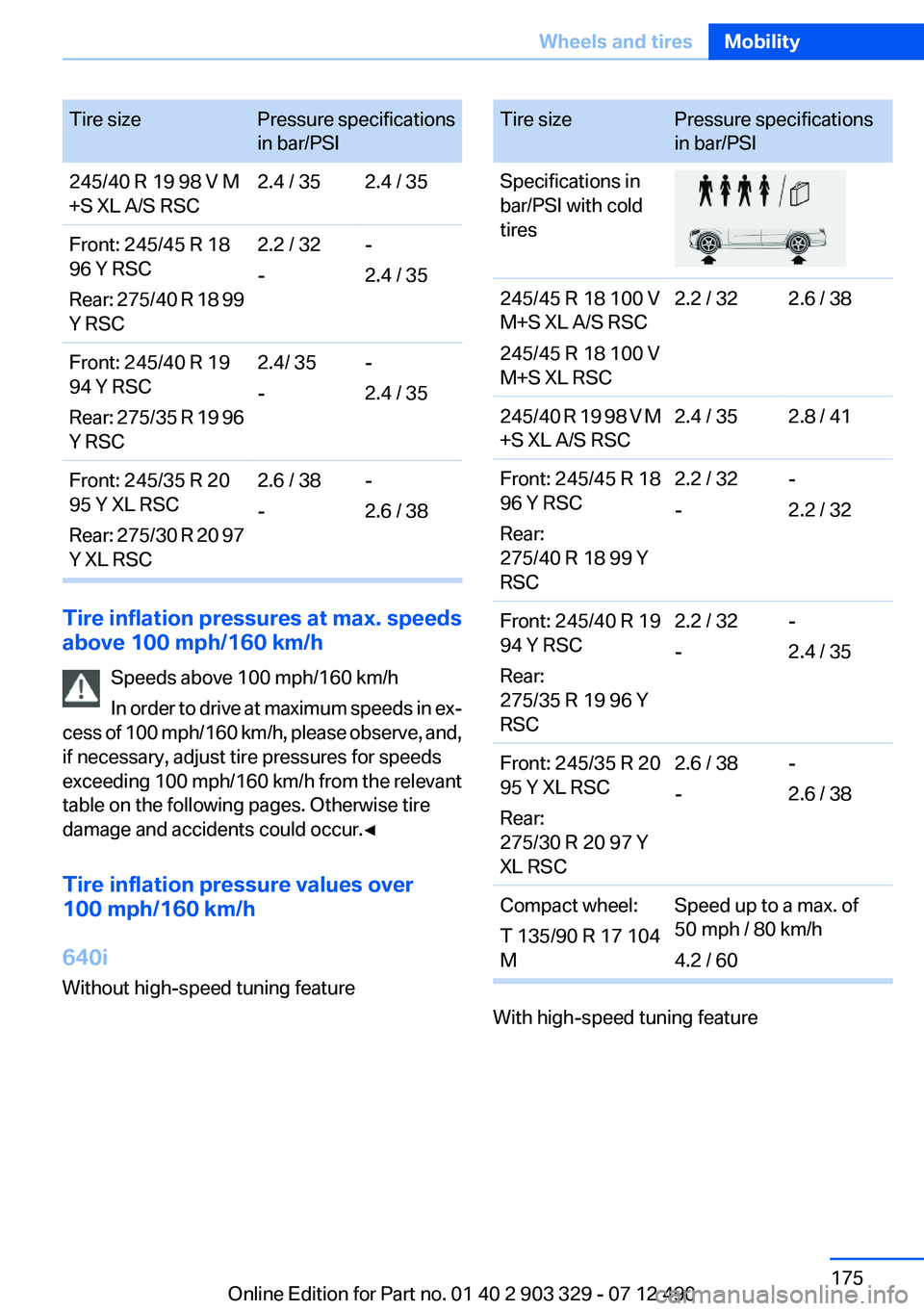
Tire sizePressure specifications
in bar/PSI245/40 R 19 98 V M
+S XL A/S RSC2.4 / 352.4 / 35Front: 245/45 R 18
96 Y RSC
Rear: 275/40 R 18 99
Y RSC2.2 / 32
--
2.4 / 35Front: 245/40 R 19
94 Y RSC
Rear: 275/35 R 19 96
Y RSC2.4/ 35
--
2.4 / 35Front: 245/35 R 20
95 Y XL RSC
Rear: 275/30 R 20 97
Y XL RSC2.6 / 38
--
2.6 / 38
Tire inflation pressures at max. speeds
above 100 mph/160 km/h
Speeds above 100 mph/160 km/h
In order to drive at maximum speeds in ex‐
cess of 100 mph/160 km/h, please observe, and,
if necessary, adjust tire pressures for speeds
exceeding 100 mph/160 km/h from the relevant
table on the following pages. Otherwise tire
damage and accidents could occur.◀
Tire inflation pressure values over
100 mph/160 km/h
640i
Without high-speed tuning feature
Tire sizePressure specifications
in bar/PSISpecifications in
bar/PSI with cold
tires245/45 R 18 100 V
M+S XL A/S RSC
245/45 R 18 100 V
M+S XL RSC2.2 / 322.6 / 38245/40 R 19 98 V M
+S XL A/S RSC2.4 / 352.8 / 41Front: 245/45 R 18
96 Y RSC
Rear:
275/40 R 18 99 Y
RSC2.2 / 32
--
2.2 / 32Front: 245/40 R 19
94 Y RSC
Rear:
275/35 R 19 96 Y
RSC2.2 / 32
--
2.4 / 35Front: 245/35 R 20
95 Y XL RSC
Rear:
275/30 R 20 97 Y
XL RSC2.6 / 38
--
2.6 / 38Compact wheel:
T 135/90 R 17 104
MSpeed up to a max. of
50 mph / 80 km/h
4.2 / 60
With high-speed tuning feature
Seite 175Wheels and tiresMobility175
Online Edition for Part no. 01 40 2 903 329 - 07 12 490
Page 176 of 232
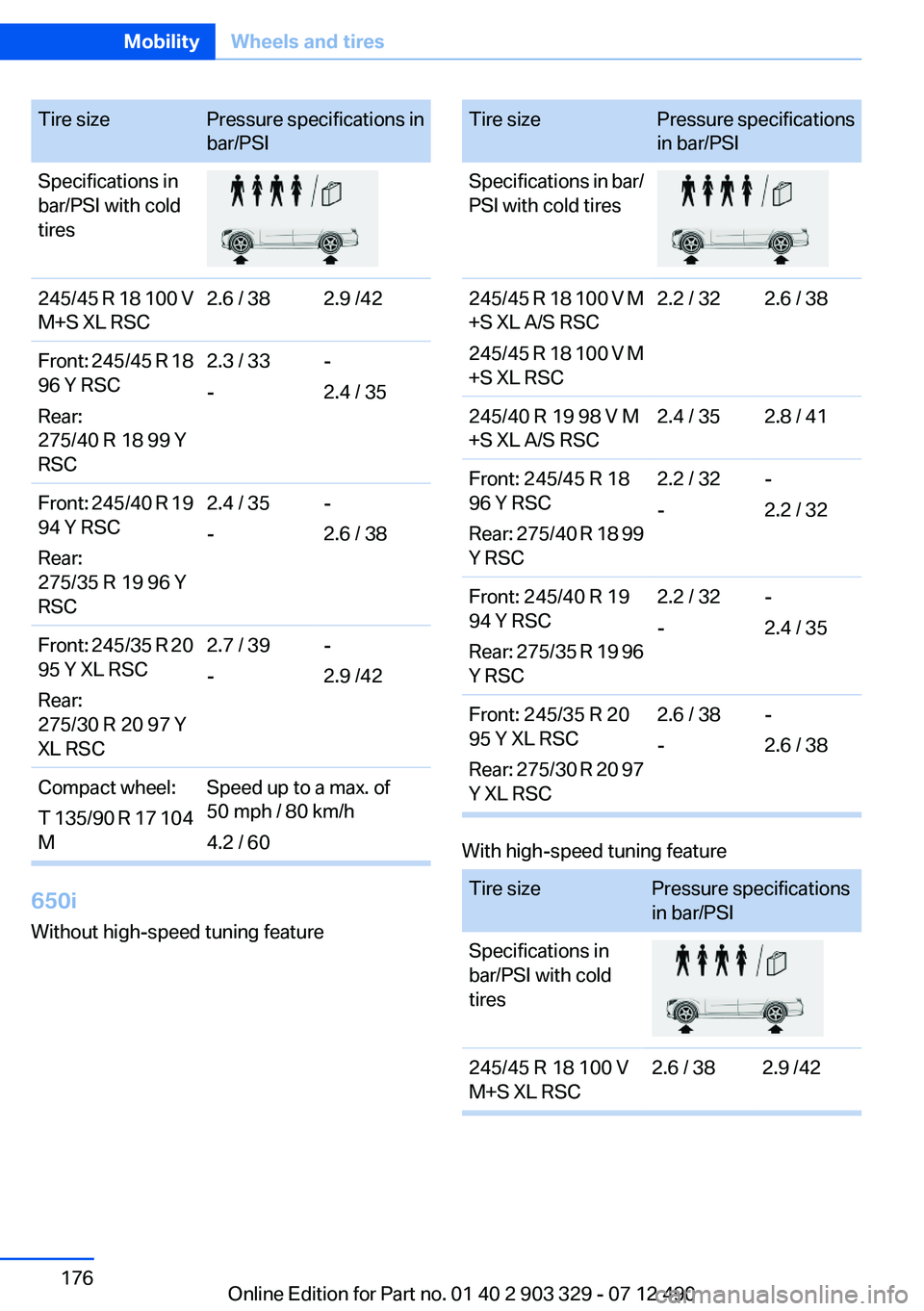
Tire sizePressure specifications in
bar/PSISpecifications in
bar/PSI with cold
tires245/45 R 18 100 V
M+S XL RSC2.6 / 382.9 /42Front: 245/45 R 18
96 Y RSC
Rear:
275/40 R 18 99 Y
RSC2.3 / 33
--
2.4 / 35Front: 245/40 R 19
94 Y RSC
Rear:
275/35 R 19 96 Y
RSC2.4 / 35
--
2.6 / 38Front: 245/35 R 20
95 Y XL RSC
Rear:
275/30 R 20 97 Y
XL RSC2.7 / 39
--
2.9 /42Compact wheel:
T 135/90 R 17 104
MSpeed up to a max. of
50 mph / 80 km/h
4.2 / 60
650i
Without high-speed tuning feature
Tire sizePressure specifications
in bar/PSISpecifications in bar/
PSI with cold tires245/45 R 18 100 V M
+S XL A/S RSC
245/45 R 18 100 V M
+S XL RSC2.2 / 322.6 / 38245/40 R 19 98 V M
+S XL A/S RSC2.4 / 352.8 / 41Front: 245/45 R 18
96 Y RSC
Rear: 275/40 R 18 99
Y RSC2.2 / 32
--
2.2 / 32Front: 245/40 R 19
94 Y RSC
Rear: 275/35 R 19 96
Y RSC2.2 / 32
--
2.4 / 35Front: 245/35 R 20
95 Y XL RSC
Rear: 275/30 R 20 97
Y XL RSC2.6 / 38
--
2.6 / 38
With high-speed tuning feature
Tire sizePressure specifications
in bar/PSISpecifications in
bar/PSI with cold
tires245/45 R 18 100 V
M+S XL RSC2.6 / 382.9 /42Seite 176MobilityWheels and tires176
Online Edition for Part no. 01 40 2 903 329 - 07 12 490
Page 177 of 232

Tire sizePressure specifications
in bar/PSI
Front: 245/45 R 18
96 Y RSC
Rear:
275/40 R 18 99 Y
RSC
2.3 / 33
-
-
2.4 / 35
Front: 245/40 R 19
94 Y RSC
Rear:
275/35 R 19 96 Y
RSC
2.5 / 36
-
-
2.6 / 38
Front: 245/35 R 20
95 Y XL RSC
Rear:
275/30 R 20 97 Y XL
RSC
2.7 / 39
-
-
2.9 /42
650i xDrive
Without high-speed tuning feature
Tire sizePressure specifications
in bar/PSI
Specifications in bar/
PSI with cold tires
245/45 R 18 100 V M
+S XL A/S RSC
245/45 R 18 100 V M
+S XL RSC
2.4 / 352.6 / 38245/40 R 19 98 V M
+S XL A/S RSC
2.6 / 382.8 / 41Front: 245/45 R 18
96 Y RSC
Rear: 275/40 R 18 99
Y RSC
2.2 / 32
-
-
2.4 / 35
Tire sizePressure specifications
in bar/PSI
Front: 245/40 R 19
94 Y RSC
Rear: 275/35 R 19 96
Y RSC
2.4 / 35
-
-
2.4 / 35
Front: 245/35 R 20
95 Y XL RSC
Rear: 275/30 R 20 97
Y XL RSC
2.6 / 38
-
-
2.6 / 38
With high-speed tuning feature
Tire sizePressure specifications
in bar/PSI
Specifications in bar/
PSI with cold tires
245/45 R 18 100 V M
+S XL A/S RSC
245/45 R 18 100 V M
+S XL RSC
2.6 / 383.0 / 44245/40 R 19 98 V M
+S XL A/S RSC
2.9 /423.1 / 45Front: 245/45 R 18
96 Y RSC
Rear: 275/40 R 18 99
Y RSC
2.4 / 35
-
-
2.6 / 38
Front: 245/40 R 19
94 Y RSC
Rear: 275/35 R 19 96
Y RSC
2.6 / 38
-
-
2.6 / 38
Front: 245/35 R 20
95 Y XL RSC
Rear: 275/30 R 20 97
Y XL RSC
2.8 / 41
-
-
2.8 / 41
Seite 177Wheels and tiresMobility177
Online Edition for Part no. 01 40 2 903 329 - 07 12 490
Page 178 of 232
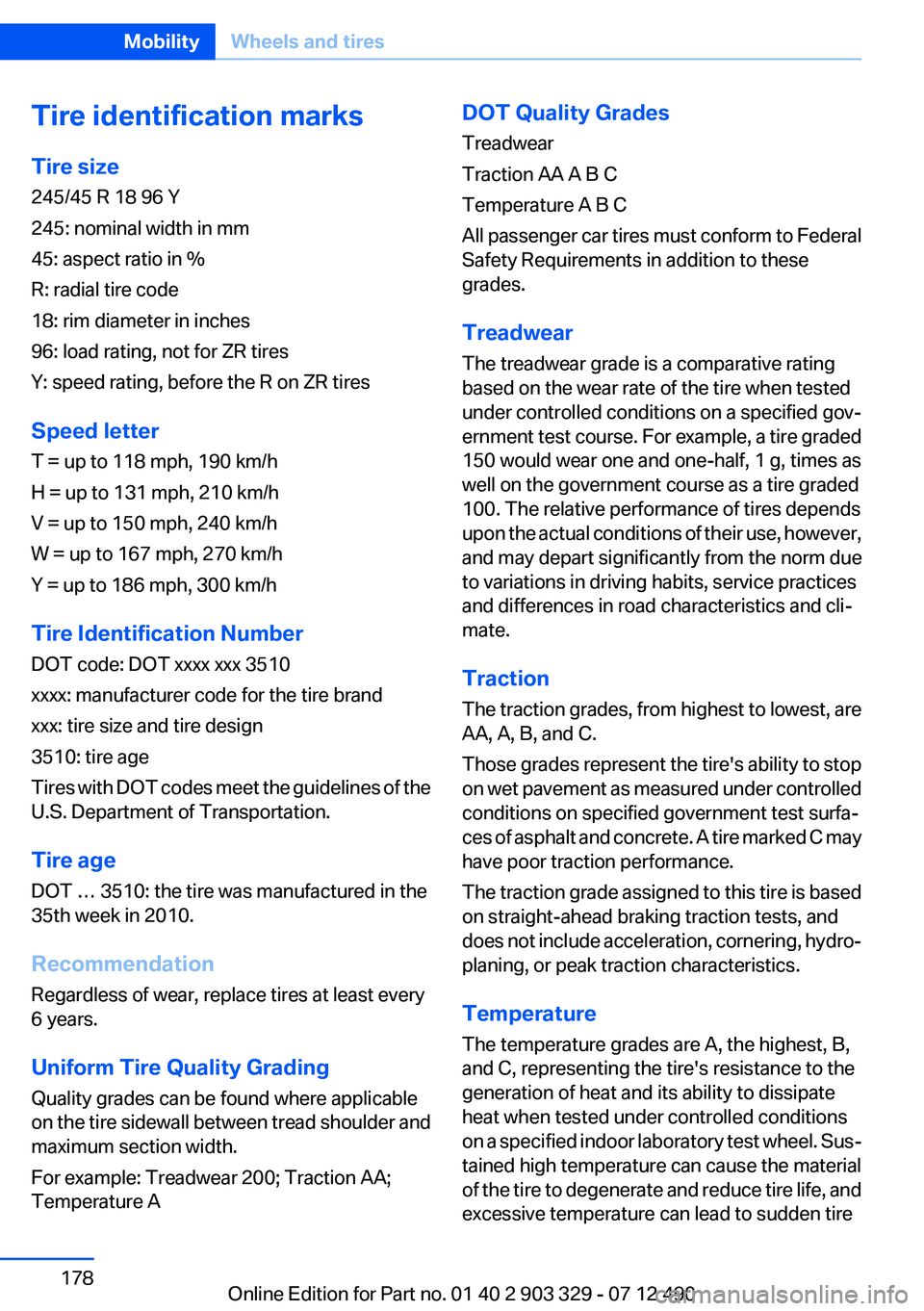
Tire identification marks
Tire size
245/45 R 18 96 Y
245: nominal width in mm
45: aspect ratio in %
R: radial tire code
18: rim diameter in inches
96: load rating, not for ZR tires
Y: speed rating, before the R on ZR tires
Speed letter
T = up to 118 mph, 190 km/h
H = up to 131 mph, 210 km/h
V = up to 150 mph, 240 km/h
W = up to 167 mph, 270 km/h
Y = up to 186 mph, 300 km/h
Tire Identification Number
DOT code: DOT xxxx xxx 3510
xxxx: manufacturer code for the tire brand
xxx: tire size and tire design
3510: tire age
Tires with DOT codes meet the guidelines of the
U.S. Department of Transportation.
Tire age
DOT … 3510: the tire was manufactured in the
35th week in 2010.
Recommendation
Regardless of wear, replace tires at least every
6 years.
Uniform Tire Quality Grading
Quality grades can be found where applicable
on the tire sidewall between tread shoulder and
maximum section width.
For example: Treadwear 200; Traction AA;
Temperature ADOT Quality Grades
Treadwear
Traction AA A B C
Temperature A B C
All passenger car tires must conform to Federal
Safety Requirements in addition to these
grades.
Treadwear
The treadwear grade is a comparative rating
based on the wear rate of the tire when tested
under controlled conditions on a specified gov‐
ernment test course. For example, a tire graded
150 would wear one and one-half, 1 g, times as
well on the government course as a tire graded
100. The relative performance of tires depends
upon the actual conditions of their use, however,
and may depart significantly from the norm due
to variations in driving habits, service practices
and differences in road characteristics and cli‐
mate.
Traction
The traction grades, from highest to lowest, are
AA, A, B, and C.
Those grades represent the tire's ability to stop
on wet pavement as measured under controlled
conditions on specified government test surfa‐
ces of asphalt and concrete. A tire marked C may
have poor traction performance.
The traction grade assigned to this tire is based
on straight-ahead braking traction tests, and
does not include acceleration, cornering, hydro‐
planing, or peak traction characteristics.
Temperature
The temperature grades are A, the highest, B,
and C, representing the tire's resistance to the
generation of heat and its ability to dissipate
heat when tested under controlled conditions
on a specified indoor laboratory test wheel. Sus‐
tained high temperature can cause the material
of the tire to degenerate and reduce tire life, and
excessive temperature can lead to sudden tireSeite 178MobilityWheels and tires178
Online Edition for Part no. 01 40 2 903 329 - 07 12 490